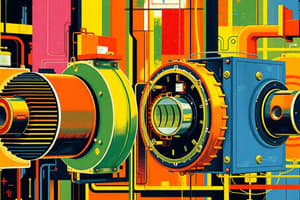Podcast
Questions and Answers
What is the main advantage of synchronous AC servo motors compared to asynchronous ones?
What is the main advantage of synchronous AC servo motors compared to asynchronous ones?
- They use a commutator and brushes.
- They operate at a lower speed.
- They have improved efficiency and precision. (correct)
- They are simpler and cheaper.
Which type of DC servo motor utilizes brushes and a commutator?
Which type of DC servo motor utilizes brushes and a commutator?
- Synchronous DC servo motor
- Brushed DC servo motor (correct)
- Asynchronous DC servo motor
- Brushless DC servo motor
In which application are AC servo motors most suitable?
In which application are AC servo motors most suitable?
- Small-scale machinery
- High power, high speed environments (correct)
- Toys and consumer electronics
- Hobby projects
What characterizes brushless DC servo motors compared to brushed ones?
What characterizes brushless DC servo motors compared to brushed ones?
How does the rotor of an asynchronous AC servo motor operate?
How does the rotor of an asynchronous AC servo motor operate?
What is a disadvantage of brushed DC servo motors?
What is a disadvantage of brushed DC servo motors?
What type of motion do linear servo motors provide?
What type of motion do linear servo motors provide?
Which of the following is NOT a characteristic of asynchronous AC servo motors?
Which of the following is NOT a characteristic of asynchronous AC servo motors?
What is the primary function of the motor in a servo system?
What is the primary function of the motor in a servo system?
What role does the sensor play in a servo motor system?
What role does the sensor play in a servo motor system?
What is the primary feature of a servo motor?
What is the primary feature of a servo motor?
Which of the following describes the controller's function in a servo motor setup?
Which of the following describes the controller's function in a servo motor setup?
Which of the following types of motors are classified as servo motors?
Which of the following types of motors are classified as servo motors?
What types of advanced control systems do servo motors use?
What types of advanced control systems do servo motors use?
What is the purpose of the feedback signal in a servo motor?
What is the purpose of the feedback signal in a servo motor?
What type of control system does the controller in a servo motor employ?
What type of control system does the controller in a servo motor employ?
What role do feedback mechanisms play in servo motors?
What role do feedback mechanisms play in servo motors?
Which control algorithm is commonly used in servo motors for optimizing performance?
Which control algorithm is commonly used in servo motors for optimizing performance?
In which industries are servo motors primarily utilized?
In which industries are servo motors primarily utilized?
What does the term 'servo' historically relate to?
What does the term 'servo' historically relate to?
How does the motor respond to the control signal generated by the controller?
How does the motor respond to the control signal generated by the controller?
What factor could lead to the termination of the control process in a servo motor?
What factor could lead to the termination of the control process in a servo motor?
What is a fundamental component of a servo motor system?
What is a fundamental component of a servo motor system?
What is a significant advantage of modern servo motors compared to historical uses?
What is a significant advantage of modern servo motors compared to historical uses?
What is a primary disadvantage of iron-core linear servo motors?
What is a primary disadvantage of iron-core linear servo motors?
Which type of linear servo motor has no iron cores?
Which type of linear servo motor has no iron cores?
What type of control signal is typically used for low-cost servo systems?
What type of control signal is typically used for low-cost servo systems?
What is the function of the controller in a servo motor system?
What is the function of the controller in a servo motor system?
Which of the following is NOT a common application of linear servo motors?
Which of the following is NOT a common application of linear servo motors?
Which control algorithm adjusts the control signal based on the error term's proportional, integral, and derivative components?
Which control algorithm adjusts the control signal based on the error term's proportional, integral, and derivative components?
Which characteristic is associated with ironless linear servo motors?
Which characteristic is associated with ironless linear servo motors?
What type of signals do digital control systems use?
What type of signals do digital control systems use?
What is one of the primary functions of a controller in relation to servo motors?
What is one of the primary functions of a controller in relation to servo motors?
Which of the following industries is NOT mentioned as a common application of servo motors?
Which of the following industries is NOT mentioned as a common application of servo motors?
What can one expect after signing up for Electrical4U's email list?
What can one expect after signing up for Electrical4U's email list?
What is the demeanor of the message towards reader engagement?
What is the demeanor of the message towards reader engagement?
What characteristic of servo motors is highlighted in the content?
What characteristic of servo motors is highlighted in the content?
Study Notes
Servo Motor: Definition and Overview
- Servo motors are electric motors that achieve precise control of position, speed, and torque via a feedback loop system.
- The term "servo" relates to its historical role as an auxiliary driver, emphasizing its high performance in modern applications.
Components of Servo Motors
- Motor: Can be AC or DC, providing mechanical power for motion.
- Sensor: Types include potentiometers and encoders; they provide feedback on position, speed, or torque.
- Controller: Compares feedback signals with desired setpoints; uses control algorithms (e.g., PID control) for precision.
Working Principle
- The controller receives a setpoint signal (the desired output) and a feedback signal (the actual output).
- An error signal is generated, indicating the difference, and the control algorithm determines the necessary adjustments to motor input.
- This process continues until the output matches the desired setpoint.
Types of Servo Motors
- AC Servo Motors: Operate on alternating current, categorized into synchronous (more efficient with precise control) and asynchronous (simpler and more rugged).
- DC Servo Motors: Use direct current and include brushed (lower efficiency and lifespan) and brushless (more efficient and durable) designs.
- Linear Servo Motors: Produce linear motion with series including iron-core (high force density) and ironless (low cogging force) types for applications demanding high precision.
Control Mechanisms
- Servo motors can be controlled using analog signals (continuous) or digital signals (discrete), depending on the application.
- Common control algorithms include:
- PID Control: Adjusts control signals based on the proportional, integral, and derivative aspects of the error signal.
Applications
- Widely used in fields that require high-precision movement such as robotics, CNC machinery, and automated manufacturing processes.
- Also utilized in medical equipment and semiconductor manufacturing for their responsiveness and fluid motion capabilities.
Studying That Suits You
Use AI to generate personalized quizzes and flashcards to suit your learning preferences.
Description
Explore the definition and working principles of servo motors in this quiz. Understand the key components including the motor, sensor, and controller, and how they work together to achieve precise motion control. Test your knowledge on the types of servo motors and their applications.





